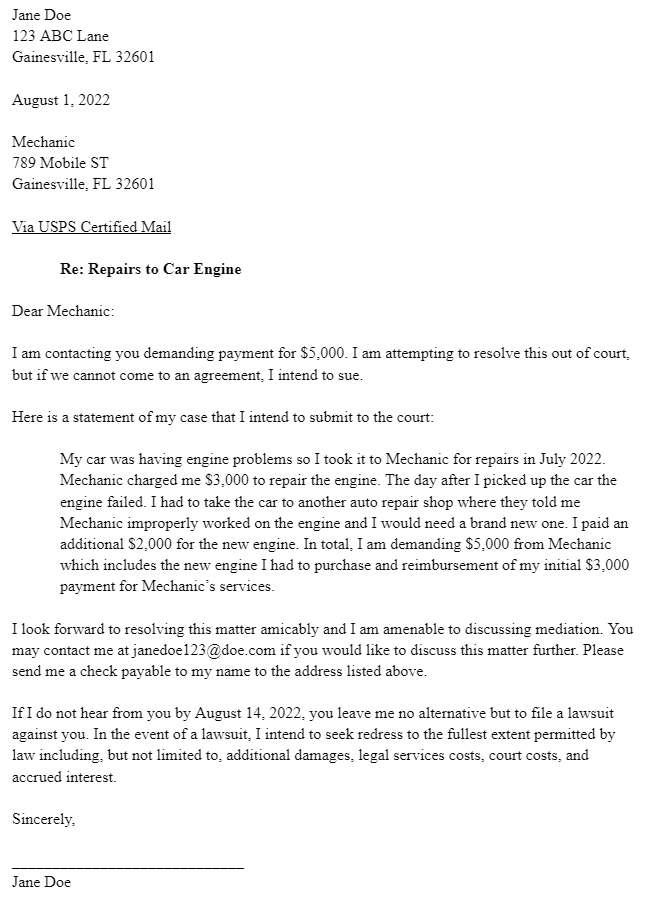Ready to create your free demand letter using our demand letter tool?
Start Demand LetterContents
Before filing a small claims lawsuit in your local small claims court consider sending a demand letter. Demand letters are essentially letters demanding payment and stating your intent to sue in small claims court if the dispute cannot be resolved amicably. Depending on your state, asking the other party to pay you back before suing them may even be required before filing a small claims lawsuit. In this article, learn about how to write a demand letter, review a sample small claims demand letter, and more.
Did you know we have a free tool powered by AI that helps you create a small claims demand letter? Check out our demand letter tool.
Why is a Small Claims Demand Letter Important?
There are three important reasons why you should send a small claims court letter of demand before filing:
Depending on what state you are filing a small claims court lawsuit in, you may be required to ask the other party to pay you back before filing. A small claims court letter of demand is an effective way of completing this requirement.
Demand letters signal to the person or business receiving it that you are serious about the problem and are willing to spend time and money to get your money or property back.
Sending a demand letter may lead to a resolution without having to go to small claims court!
How to Ask for your Money or Property Back in a Small Claims Court Demand Letter
Requesting your money or property back from someone can be done orally or in writing, but it is recommended you do so in writing. While there is no restriction against demanding your payment or property back via text message, writing a letter can sometimes be very effective.
Once you have sent a demand letter, keep it for your records. You can bring it to the small claims court hearing and show it to the judge (especially if the person you are suing claims they didn't receive the letter).
What to include in the demand letter
Unsure of what to include in your demand letter? Below we have included a small claims court demand letter example as well as some considerations.
Here are a few things to consider adding to your demand letter:
How much money are you owed? For example, how much money did you pay for a service that was improperly performed?
How can the other party reach you? Consider listing an email to keep your communications with the other party in writing.
Where should the other party send you payment should they want to resolve this out of court?
Specify how you would like your property to be returned to you if you are demanding your property back.
Why you are entitled to a return of your money?
Consider giving the other party 14 days to respond to you. Include this in your letter, and state that if they do not respond within that time, you intend to sue them in small claims court.
Sample Small Claims Court Demand Letter Template
Did you know we have a free tool powered by AI that helps you create a small claims demand letter? Check out our demand letter tool.
Here is a video on how our demand letter tool works:
Below is a small claims demand letter template you can use when constructing your own demand letter. This demand letter template can be easily modified for your particular situation. For the sample small claims demand letter below, the dispute is between a car owner and a mechanic. Remember this is only an example of a demand letter for small claims court. Use as many case-specific details when writing your own small claims court demand letter.

How to Send a Demand Letter
We recommend sending your small claims court demand letter via email or mail. For letters that you mail, consider the following:
Tracking. Make sure to track your small claims demand letter. With tracking, you will know if the letter reached the individual or business you sent the demand letter.
Signature Required. You do not necessarily need a signature request. When you send a letter with the receiver's signature requested, the postal carrier must hand-deliver the letter and the person must sign for the letter. If you are sending this letter to an individual, it can be difficult for the post office to obtain the signature.
Once the post office attempts delivery 2-3 times, the post office returns the letter to the sender as "undeliverable." We don't recommend sending demand letters to individuals at a home address with a signature required. A signature-required mailing does work better when you send the letter to a business that is open during regular delivery hours.
Next Steps After Sending a Demand Letter
How long after you send your demand letter to the other party to sue them in small claims?
Check if your local small claims court has a suggested timeline. If your local small claims court has no information on this, consider giving the other party around 14 days to respond to you. Remember to add a sentence about this in your demand letter.
What to do if the demand letter doesn't work?
So you sent someone a demand letter and they still have not returned your money or property, now what? It is time to consider filing a lawsuit in small claims court.
Suing in Small Claims Court
Types of cases that can be filed in small claims
So long as there isn't another court better suited to hear the case, then the lawsuit can be filed in small claims. The most common types of small claims cases are:
Landlord/Tenant disputes over the security deposit.
Landlord/Tenant disputes over early termination of the lease.
Unpaid rent.
Roommate disputes.
Disputes over loans.
Contracts (written and oral).
Auto accidents.
Disputes over auto repairs.
Disputes over remodeling or home repairs.
Damage caused to property.
Unpaid bills.
Small claims court limits
To be able to file a small claims court lawsuit you are capped at the amount you can sue for, also known as "small claims court limits.” Depending on the state you are suing in there will be a different limit. Check with your local small claims court to find out the small claims court limit in your area.
If you are owed more than the amount you can sue for, you can still sue for the maximum amount allowed, but you will need to waive any additional amount over the limit.
How much does it cost to sue someone in small claims?
The amount you will pay to file a small claims lawsuit depends on how much you are suing for. Check with your local small claims court to find out about filing fees but generally, it is anywhere from $15-$75 to file a lawsuit in small claims court. If you cannot afford to pay court fees, you can ask the court if they have fee waivers. In addition to filing fees, you may need to pay for serving the lawsuit which can range between $0 - $125. Serving is the act of notifying someone that they have been sued. There are very specific rules to follow related to serving.
What is a small claims court hearing like?
Small claims hearings are meant to be quick and informal. Here is what you can expect:
Right before the hearing, the judge will ask the parties to show each other the evidence that they have brought with them. This is the time to show in court that you sent a demand letter.
The Judge will ask the person who is suing why they are suing. The judge will turn to the person who has been sued and ask them for their side of the story.
The hearing will last around 15 minutes.
The judge will ask the party to show their evidence (Invoices, contracts, receipts, etc.) they have brought to court that day. Sometimes the judge will keep the evidence, other times you will get the evidence right back.
Very rarely will a judge tell the parties their decision immediately after the hearing. Instead, the judge will tell the parties that the decision will be mailed to them (which usually takes a few weeks to two months or so).
How do I prepare for the small claims hearing?
To prepare for your small claims court hearing:
Research the law. If you are unsure about your case, conduct your own research about the law or reach out to an attorney.
Prepare your evidence. Demand letters, invoices, contracts, receipts, etc. You want to have your evidence organized with titles, dates, and why that piece of evidence is important. All your evidence should be geared towards showing the judge why you are correct.
Prepare what to say. During the hearing, the judge will ask the person suing why they are suing. If you are being sued, you will be asked why you don't owe the other party money.
Get your receipts for costs ready. For example, your filing fees and any process server costs. Make sure to let the judge know that you would like to be reimbursed for costs.
Print enough copies of all your evidence. You will need at least three copies (one for you, one for the judge, and one for the other side).

Camila Lopez
Legal Educator at JusticeDirect. Camila holds a law degree and is a certified mediator. Her passion is breaking down complicated legal processes so that people without an attorney can get justice.
